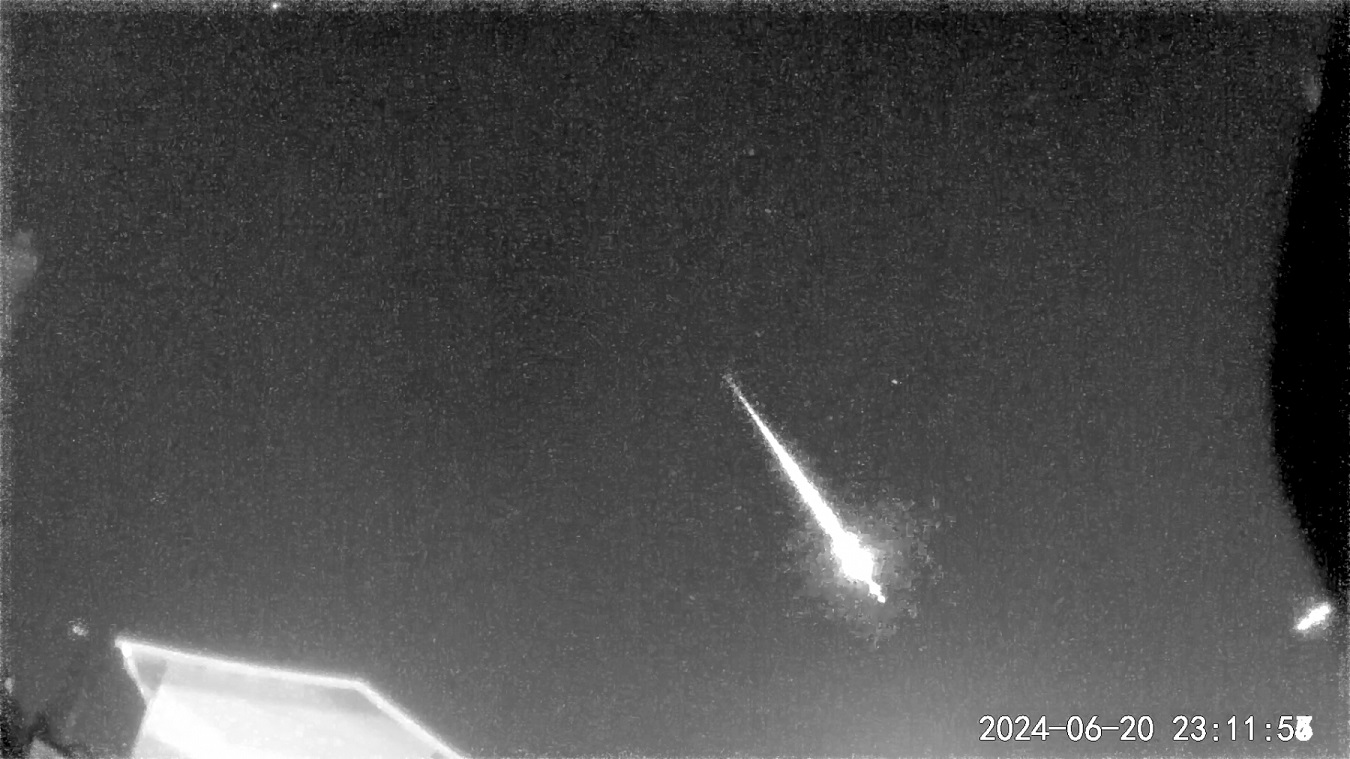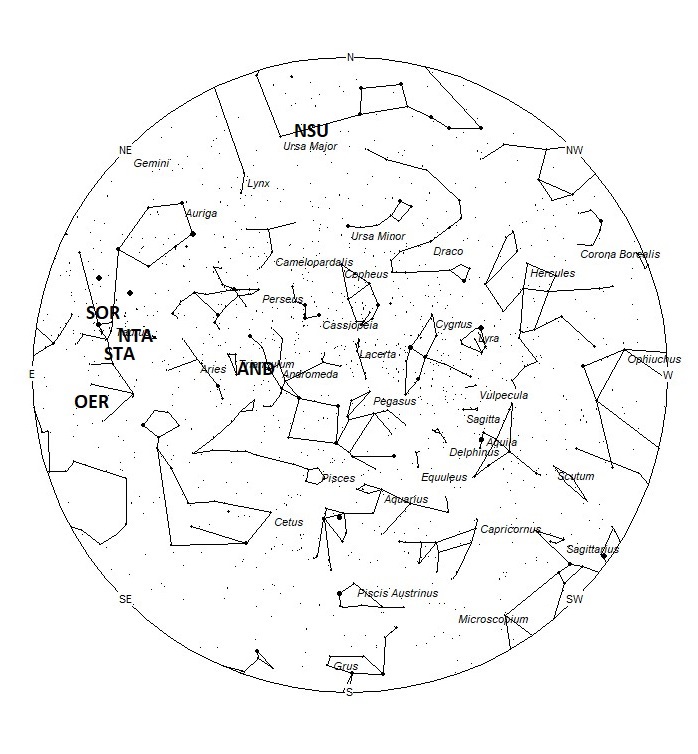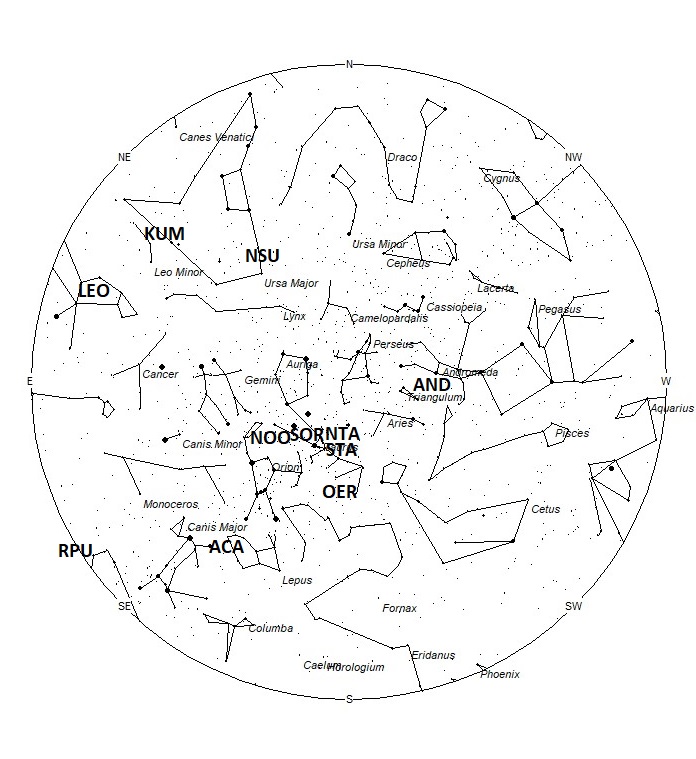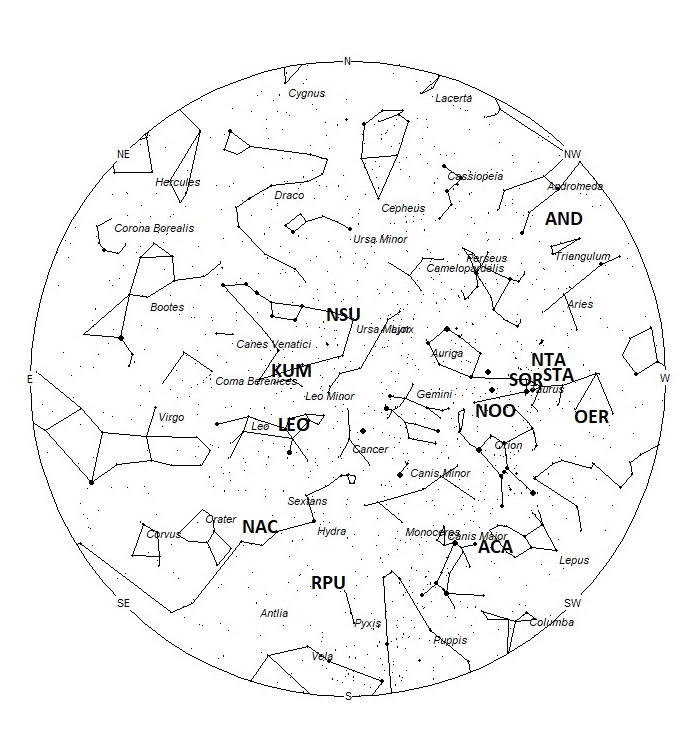
During this period, the moon wanes from its full phase to one-half illuminated. It will rise in the evening sky and remain in the sky the remainder of the night. This is the worst time of the month to try and view meteor activity as the bright moon will obscure all but the brighter meteors. The estimated total hourly rates for evening observers this weekend should be near 2 as seen from mid-northern latitudes (45N) and 1 as seen from tropical southern locations (25S) For morning observers, the estimated total hourly rates should be near 13 as seen from mid-northern latitudes (45N) and 8 as seen from tropical southern locations (25S). Rates are reduced during this period due to the intense moonlight during the nighttime hours. The actual rates seen will also depend on factors such as personal light and motion perception, local weather conditions, alertness, and experience in watching meteor activity. Note that the hourly rates listed below are estimates as viewed from dark sky sites away from urban light sources. Observers viewing from urban areas will see less activity as only the brighter meteors will be visible from such locations.
The radiant (the area of the sky where meteors appear to shoot from) positions and rates listed below are exact for Saturday night/Sunday morning November 16/17. These positions do not change greatly day to day so the listed coordinates may be used during this entire period. Most star atlases (available online and at bookstores and planetariums) will provide maps with grid lines of the celestial coordinates so that you may find out exactly where these positions are located in the sky. I have also included charts of the sky that display the radiant positions for evening, midnight, and morning. The center of each chart is the sky directly overhead at the appropriate hour. These charts are oriented for facing south but can be used for any direction by rotating the charts to the desired direction. A planisphere or computer planetarium program is also useful in showing the sky at any time of night on any date of the year. Activity from each radiant is best seen when it is positioned highest in the sky, either due north or south along the meridian, depending on your latitude. Radiants that rise after midnight will not reach their highest point in the sky until daylight. For these radiants, it is best to view them during the last few hours before dawn. It must be remembered that meteor activity is rarely seen at its radiant position. Rather they shoot outwards from the radiant, so it is best to center your field of view so that the radiant lies toward the edge and not the center. Viewing there will allow you to easily trace the path of each meteor back to the radiant (if it is a shower member) or in another direction if it is sporadic. Meteor activity is not seen from radiants that are located far below the horizon. The positions below are listed in a west to east manner in order of right ascension (celestial longitude). The positions listed first are located further west therefore are accessible earlier in the night while those listed further down the list rise later in the night.
These sources of meteoric activity are expected to be active this week
Details of each source will continue next week when viewing conditions are more favorable,
The list below offers the information in tabular form of the showers that I feel are within reach of the visual observer to discern. Hourly rates are often less than one, so these sources are rarely listed as visual targets in most meteor shower lists. If you are like me and wish to associate as many meteors as possible with known sources, then you will appreciate these listings. Before listing meteors from these obscure sources, you should attempt to prove these meteors belong to them and are not chance alignments of sporadic meteors. You can note parameters such as duration, length, radiant distance and the elevation of each meteor to help compute the probability of shower association. It should be remembered that slow meteors can be seen from fast showers, but fast meteors cannot be produced from slow showers. Slower showers are those with velocities less than 35/km per second. Slow meteors can appear from fast showers when they appear close to the radiant or low in the sky. The table located on page 22 of the IMO’s 2024 Meteor Shower Calendar is a big help in aiding in the identification of meteors. If you record the length and duration of each meteor, you can use this chart to check the probability of the meteor belonging to a shower of known velocity. If the angular velocity is similar to the figure in the table, then your meteor probably belongs to that shower. Rates and positions are exact for Saturday night/Sunday morning.
| SHOWER | DATE OF MAXIMUM ACTIVITY | CELESTIAL POSITION | ENTRY VELOCITY | CULMINATION | HOURLY RATE | CLASS |
| RA (RA in Deg.) DEC | Km/Sec | Local Standard Time | North-South | |||
| Andromedids (AND) | Nov 06 | 01:34 (023) +35 | 16 | 23:00 | <1 – <1 | III |
| Southern Taurids (STA) | Nov 05 | 04:01 (060) +15 | 24 | 01:00 | 1- 1 | II |
| omicron Eridanids (OER) | Nov 05 | 04:05 (061) -02 | 27 | 01:00 | <1 – <1 | IV |
| Northern Taurids (NTA) | Nov 08 | 04:10 (063) +24 | 27 | 01:00 | 1 – <1 | II |
| Southern chi Orionids (ORS) | Nov 28 | 04:27 (069) +17 | 28 | 02:00 | <1 – <1 | IV |
| November Orionids (NOO) | Nov 28 | 05:28 (082) +16 | 44 | 03:00 | <1 – <1 | II |
| alpha Canis Majorids (ACA) | Nov 21 | 06:08 (092) -19 | 44 | 04:00 | <1 – <1 | IV |
| rho Puppids (RPU) | Nov 08 | 09:02 (136) -26 | 57 | 05:00 | <1 – <1 | IV |
| November sigma Ursae Majorids (NSU) | Nov 23 | 09:19 (140) +62 | 51 | 05:00 | <1 – <1 | IV |
| Leonids (LEO) | Nov 17 | 10:14 (154) +22 | 70 | 07:00 | 5 – 4 | I |
| November alpha Corvids (NAC) | Nov 28 | 10:26 (157) -11 | 67 | 07:00 | <1 – <1 | IV |
| kappa Ursae Majorids (KUM) | Nov 06 | 10:27 (157) +42 | 64 | 07:00 | <1 – <1 | IV |
You can keep track of the activity of these meteor showers as well as those beyond the limits of visual observing by visiting the NASA Meteor Shower Portal. You can move the sky globe to see different areas of the sky. Colored dots indicate shower meteors while white dots indicate sporadic (random) activity. The large orange disk indicates the position of the sun so little activity will be seen in that area of the sky.
Class Explanation: A scale to group meteor showers by their intensity:
- Class I: the strongest annual showers with Zenith Hourly Rates normally ten or better.
- Class II: reliable minor showers with ZHR’s normally two to ten.
- Class III: showers that do not provide annual activity. These showers are rarely active yet have the potential to produce a major display on occasion.
- Class IV: weak minor showers with ZHR’s rarely exceeding two. The study of these showers is best left to experienced observers who use plotting and angular velocity estimates to determine shower association. These weak showers are also good targets for video and photographic work. Observers with less experience are urged to limit their shower associations to showers with a rating of I to III.
 American Meteor Society
American Meteor Society


